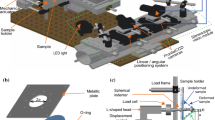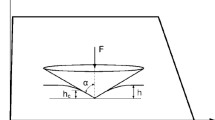Abstract
This work uses a method based on indentation to characterize a polydimethylsiloxane (PDMS) elastomer submerged in an organic solvent (decane, heptane, pentane, or cyclohexane). An indenter is pressed into a disk of a swollen elastomer to a fixed depth, and the force on the indenter is recorded as a function of time. By examining how the relaxation time scales with the radius of contact, one can differentiate the poroelastic behavior from the viscoelastic behavior. By matching the relaxation curve measured experimentally to that derived from the theory of poroelasticity, one can identify elastic constants and permeability. The measured elastic constants are interpreted within the Flory–Huggins theory. The measured permeability indicates that the solvent migrates in PDMS by diffusion, rather than by convection. This work confirms that indentation is a reliable and convenient method to characterize swollen elastomers.












Similar content being viewed by others
References
R. Duncan: The dawning era of polymer therapeutics. Nat. Rev. Drug Discovery 2, 347 (2003).
B. Jeong, Y.H. Bae, D.S. Lee, and S.W. Kim: Biodegradable block copolymers as injectable drug delivery systems. Nature 388, 860 (1997).
R. Langer: Drug delivery and targeting. Nature 392, 5 (1998).
Y. Luo and M.S. Shoichet: A photolabile hydrogel for guided three-dimensional cell growth and migration. Nat. Mater. 3, 249 (2004).
A.P. Nowak, V. Breedveld, L. Pakstis, B. Ozbas, D.J. Pine, D. Pochan, and T.J. Deming: Rapidly recovering hydrogel scaffolds from self-assembling diblock copolypeptide amphiphiles. Nature 417, 424 (2002).
D.J. Beebe, J.S. Moore, J.M. Bauer, Q. Yu, R.H. Liu, C. Devadoss, and B.H. Jo: Functional hydrogel structures for autonomous flow control inside microfluidic channels. Nature 404, 588 (2000).
M. Tokeshi, T. Minagawa, K. Uchiyama, A. Hibara, K. Sato, H. Hisamoto, and T. Kitamori: Continuous-flow chemical processing on a microchip by combining microunit operations and a multiphase flow network. Anal. Chem. 74, 1565 (2002).
S. Cai, Y. Lou, P. Ganguly, A. Robisson, and Z. Suo: Force generated by a swelling elastomer subject to constraint. J. Appl. Phys. 107, 103535 (2010).
X. Zhao, N. Huebsch, D.J. Mooney, and Z. Suo: Stress-relaxation behavior in gels with ionic and covalent crosslinks. J. Appl. Phys. 107, 063509 (2010).
W.C. Oliver and G.M. Pharr: An improved technique for determining hardness and elastic modulus using load and displacement sensing indentation experiments. J. Mater. Res. 7, 1564 (1992).
D.M. Ebenstein and L.A. Pruitt: Nanoindentation of soft hydrated materials for application to vascular tissues. J. Biomed. Mater. Res. Part A 69, 222 (2004).
J.D. Kaufman, G.J. Miller, E.F. Morgan, and C.M. Klapperich: Time-dependent mechanical characterization of poly(2-hydroxyethyl methacrylate) hydrogels using nanoindentation and unconfined compression. J. Mater. Res. 23, 1472 (2008).
G. Constantinides, Z.I. Kalcioglu, M. McFarland, J.F. Smith, and K.J. Van Vliet: Probing mechanical properties of fully hydrated gels and biological tissues. J. Biomech. 41, 3285 (2008).
M. Galli, K.S.C. Comley, T.A.V. Shean, and M.L. Oyen: Viscoelastic and poroelastic mechanical characterization of hydrated gels. J. Mater. Res. 24, 973 (2009).
M. Galli and M.L. Oyen: Spherical indentation of a finite poroelastic coating. Appl. Phys. Lett. 93, 031911 (2008).
M. Galli and M.L. Oyen: Fast indentation of poroelastic parameters from indentation tests. CMES 48, 241 (2009).
S. Chiravarambath, N.K. Simha, R. Namani, and J.L. Lewis: Poroviscoelastic cartilage properties in the mouse from indentation. J. Biomech. Eng. 131, 011004 (2009).
W.C. Lin, K.R. Shull, C.Y. Hui, and Y.Y. Lin: Contact measurement of internal fluid flow within poly(n-isopropylacrylamide) gels. J. Chem. Phys. 127, 094906 (2007).
C.Y. Hui, Y.Y. Lin, F.C. Chuang, K.R. Shull, and W.C. Ling: A contact mechanics method for characterizing the elastic properties and permeability of gels. J. Polym. Sci., Part B: Polym. Phys. 43, 359 (2006).
Y.Y. Lin and B.W. Hu: Load relaxation of a flat rigid circular indenter on a gel half space. J. Non-Cryst. Solids 352, 4034 (2006).
Y. Hu, X. Zhao, J.J. Vlassak, and Z. Suo: Using indentation to characterize the poroelasticity of gels. Appl. Phys. Lett. 96, 121904 (2010).
M.W. Toepke and D.J. Beebe: PDMS absorption of small molecules and consequences in microfluidic applications. Lab Chip 6, 1484 (2006).
J.N. Lee, C. Park, and G.M. Whitesides: Solvent compatibility of poly(dimethylsiloxane)-based microfluidic devices. Anal. Chem. 75, 6544 (2003).
W. Hong, X. Zhao, J. Zhou, and Z. Suo: A theory of coupled diffusion and large deformation in polymeric gels. J. Mech. Phys. Solids 56, 1779 (2008).
M. Doi: Gel dynamics. J. Phys. Soc. Jpn. 78, 052001 (2009).
K. Terzaghi: The calculation of permeability numbers of the clay out of the process of the hydrodynamic phenomenon tension. Sitzungsber. Akad. Wiss. Wien Math.–Naturewiss. Kl., Abt. IIa 132, 125 (1923).
M.A. Biot: General theory of three-dimensional consolidation. J. Appl. Phys. 12, 155 (1941).
I.N. Sneddon: The relation between load and penetration in the axisymmetric Boussinesq problem for a punch of arbitrary profile. Int. J. Eng. Sci. 3, 47 (1965).
Y. Li and T. Tanaka: Kinetics of swelling and shrinking of gels. J. Chem. Phys. 92, 1365 (1990).
M.R. Vanlandingham, N-K. Chang, P.L. Drzal, C.C. White, and S-H. Chang: Viscoelastic characterization of polymers using instrumented indentation. I. Quasi-static testing. J. Polym. Sci., Part B: Polym. Phys. 43, 1794 (2005).
I-K. Lin, K-S. Ou, Y-M. Liao, Y. Liu, K-S. Chen, and X. Zhang: Viscoelastic characterization and modeling of polymer transducers for biological applications. J. Microelectromech. Syst. 18, 1087 (2009).
J.D. Ferry: Viscoelastic Properties of Polymers, 3rd ed. (John Wiley and Sons, New York, 1980).
K.J. Johnson: Contact Mechanics (Cambridge University Press, New York, 1987).
D.C. Douglass and D.W. McCall: Diffusion in paraffin hydrocarbons. J. Phys. Chem. 62, 1102 (1958).
E. Fishman: Self-diffusion in liquid n-pentane and n-heptane. J. Phys. Chem. 59, 469 (1955).
M. Holz, S.R. Heil, and A. Sacco: Temperature-dependent self-diffusion coefficients of water and six selected molecular liquids for calibration in accurate H NMR PFG measurements. Phys. Chem. Chem. Phys. 2, 4740 (2000).
E. Geissler and A. M. Hecht: The Poisson ratio in polymer gels. 2. Macromolecules 14, 185 (1981).
S. Hirotsu: Softening of bulk modulus and negative Poisson’s ratio near the volume phase transition of polymer gels. J. Chem. Phys. 94, 3949 (1991).
J. Tang, M.A. Tung, J. Lelievre, and Y. Zeng: Stress–strain relationships for gellan gels in tension, compression and torsion. J. Food Eng. 31, 511 (1997).
D.R. Paul and O.M. Ebra-Lima: Pressure-induced diffusion of organic liquids through highly swollen polymer membranes. J. Appl. Polym. Sci. 14, 2201 (1970).
D.R. Paul and O.M. Ebra-Lima: The mechanism of liquid transport through swollen polymer membranes. J. Appl. Polym. Sci. 15, 2199 (1971).
D.R. Paul: Further comments on the relation between hydraulic permeation and diffusion. J. Polym. Sci., Polym. Phys. Ed. 12, 1221 (1974).
D.R. Paul: Reformulation of the solution-diffusion theory of reverse osmosis. J. Membr. Sci. 241, 371 (2004).
P. Meares: On the mechanism of desalination by reversed osmotic flow through cellulose acetate membranes. Eur. Polym. J. 2, 241 (1966).
A. Peterlin and H. Yasuda: Comments on the relation between hydraulic permeability and diffusion in homogeneous swollen membranes. J. Polym. Sci., Polym. Phys. Ed. 12, 1215 (1974).
H. Yasuda and A. Peterlin: Diffusive and bulk flow transport in polymers. J. Appl. Polym. Sci. 17, 433 (1973).
J.G. Wijmans and R.W. Baker: The solution-diffusion model: A review. J. Membr. Sci. 107, 1 (1995).
T. Tanaka and D.J. Fillmore: Kinetics of swelling of gels. J. Chem. Phys. 70, 1214 (1979).
T. Yamaue and M. Doi: Swelling dynamics of constrained thin-plate gels under an external force. Phys. Rev. E: Stat. Nonlinear Soft Matter Phys. 70, 011401 (2004).
T. Hajsz, I. Csetneki, G. Filipcsei, and M. Zrinyi: Swelling kinetics of anisotropic filler loaded PDMS networks. Phys. Chem. Chem. Phys. 8, 977 (2006).
P.J. Flory: Principles of Polymer Chemistry (Cornell University, Ithaca, NY, 1953).
P.J. Flory: Thermodynamics of high polymer solutions. J. Chem. Phys. 10, 51 (1942).
M.L. Huggins: Solutions of long chain compounds. J. Chem. Phys. 9, 440 (1941).
M. Braden, D. Latham, and M.P. Patel: Observations on the swelling of cross-linked poly(dimethylsiloxane) networks by solvents. Eur. Polym. J. 41, 3069 (2005).
M. Gottlieb and M. Herskowitz: Estimation of the χ parameter for poly(dimethylsiloxane) solutions by the UNIFAC group contribution method. Macromolecules 14, 1468 (1981).
P.J. Flory: Thermodynamics of polymer solutions. Fifteenth spiers memorial lectures. Discuss. Faraday Soc. 49, 7 (1970).
P.J. Flory and H. Shih: Thermodynamics of solutions of poly(dimethylsiloxane) in benzene, cyclohexane, and chlorobenzene. Macromolecules 5, 761 (1972).
N. Kuwahara, T. Okazawa, and M. Kaneko: Osmotic pressures of moderately concentrated polydimethylsiloxane solutions. J. Polym. Sci., Part C 23, 543 (1968).
J. Schurz: Rheology of polymer solutions of the network type. Prog. Polym. Sci. 16, 1 (1991).
M. Grassi, C. Sandolo, D. Perin, T. Coviello, R. Lapasin, and G. Grassi: Structural characterization of calcium alginate matrices by means of mechanical and release tests. Molecules 14, 3003 (2009).
W.V. Vadakan and G.W. Scherer: Measuring permeability of rigid materials by a beam-bending method: II, Porous glass. J. Am. Ceram. Soc. 83, 2240 (2000).
T. Boontheekul, H-J. Kong, and D.J. Mooney: Controlling alginate gel degradation utilizing partial oxidation and bimodal molecular-weight distribution. Biomaterials 26, 2455 (2005).
ACKNOWLEDGMENTS
This work is supported by the National Science Foundation (NSF) (CMMI-0800161), Multidisciplinary University Research Initiative (MURI) (W911NF-09-1-0476), and Materials Research Science and Engineering Center (MRSEC) at Harvard University.
Author information
Authors and Affiliations
Corresponding author
Rights and permissions
About this article
Cite this article
Hu, Y., Chen, X., Whitesides, G.M. et al. Indentation of polydimethylsiloxane submerged in organic solvents. Journal of Materials Research 26, 785–795 (2011). https://doi.org/10.1557/jmr.2010.35
Received:
Accepted:
Published:
Issue Date:
DOI: https://doi.org/10.1557/jmr.2010.35




